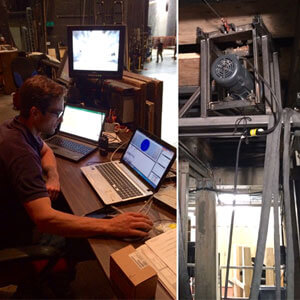Backstage with Matthew - October 18

We’ve just come out of a unique period in which we’ve had two completely different turntables playing against each other (“in repertory”) in The Makropulos Case and Don Pasquale. I don’t recall another time recently when we’ve had that situation so thought it would be interesting to delve into these stage devices. You can see the changeover from one turntable to the other in this fun time-lapse video from last week.
Turntables are under the purview of the carpentry crew, and fall under the responsibility of our Rigging and Automation Supervisor, Philip Heron. Philip, who has been with us since 2002, came out of the world of special effects at Lucasfilm/ILM and, with his skills in mechanical engineering, brings huge expertise to the world of backstage automation. I recently went on a tour of our two turntables with Philip and our Master Carpenter David Hatch.
Not only are the two turntables physically different structures, they also have completely different operations. The Makropulos turntable is a hydraulic system, made up of about 200 pieces forming a spider-web structure on which sits the flooring, or deck (seen below). There are five concentric circles, each of which can be operated independently in either direction. It’s a system one doesn’t see much anymore, but was machined in the SFO shops before the 1996 renovations and has served the company admirably in productions like Elektra, Dangerous Liaisons, Saint François, etc. It’s also traveled to Las Vegas for a multi-media car show!



The hydraulic system is easy to set-up, very easy to troubleshoot and can take a huge amount of weight. The operator sits at a control station in the basement (see photos) with a video feed of the stage. Using analogue, manual controls, the operator opens and closes valves that release hydraulic fluid through the system for each of the concentric circles, drawing on a hydraulic pump in the sub-basement (yes, we go down deep!). Marks on the set indicate when the turntable is in place: it’s a very human, nuanced operation, speeding up and slowing down as needed by the music. As Philip notes, “It’s like farm machinery”—it does only what it needs to and you can fix it immediately if it goes wrong.
The Pasquale turntable, on the other hand, is powered by electronic motors: 2 large DC motors attached just under the stage floor, driving large rubber wheels that press on a metal circular flange, turning the deck. It’s a much more common system these days, with the motors usually traveling with the production as did these from Santa Fe. Everything is computerized: positions are set during the technical rehearsals, and speeds and timings are refined through the rehearsal process. The operator sits on the fly rail, operating everything from a laptop (although a large safety button is easily to hand in the event of a problem). Unlike the spider-web of the hydraulic system, the electronic system has a center disc powered by the motors, off which then come 15 large ‘pie’ wedges that sit on wheels. The fastest turn in Pasquale is a 180-degree turn that takes about 20 seconds.
In both shows, the turntables are used real-time during defined musical passages. As with any visible scene change, there is no room for error. These are perfectly rehearsed, choreographed and executed theatrical moves by a highly trained crew. It’s one of the great examples of the complex systems that we use to bring the magic to life on stage, and the tremendously talented crew who develop, build and execute these systems. Now, next time you see something turning in a production, you can imagine what’s sitting under that floor and wonder: is this one hydraulic or electric!

